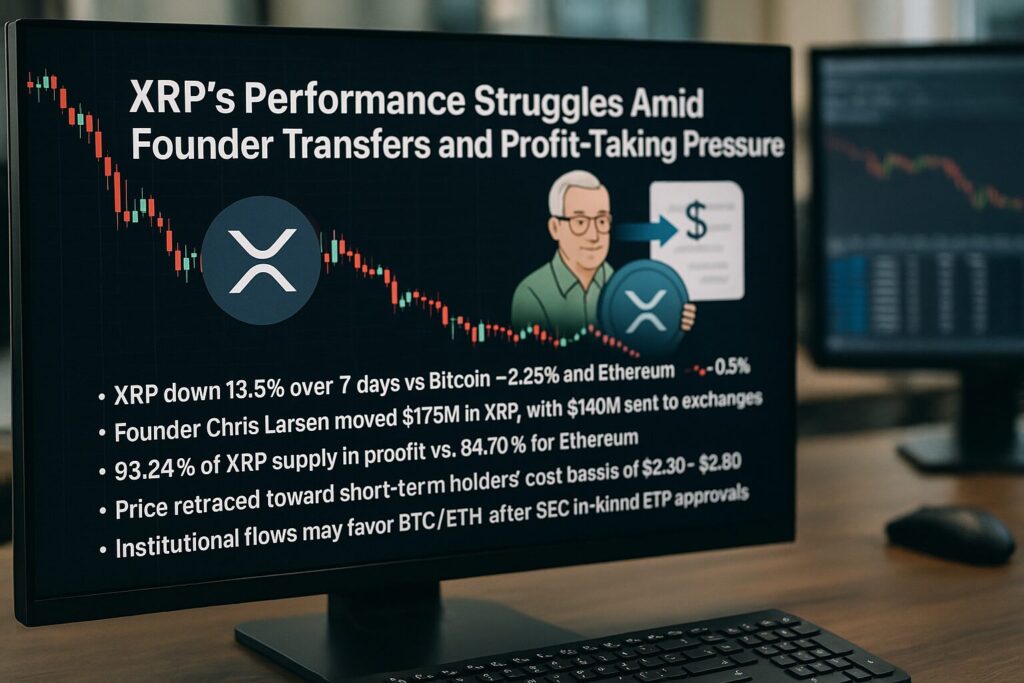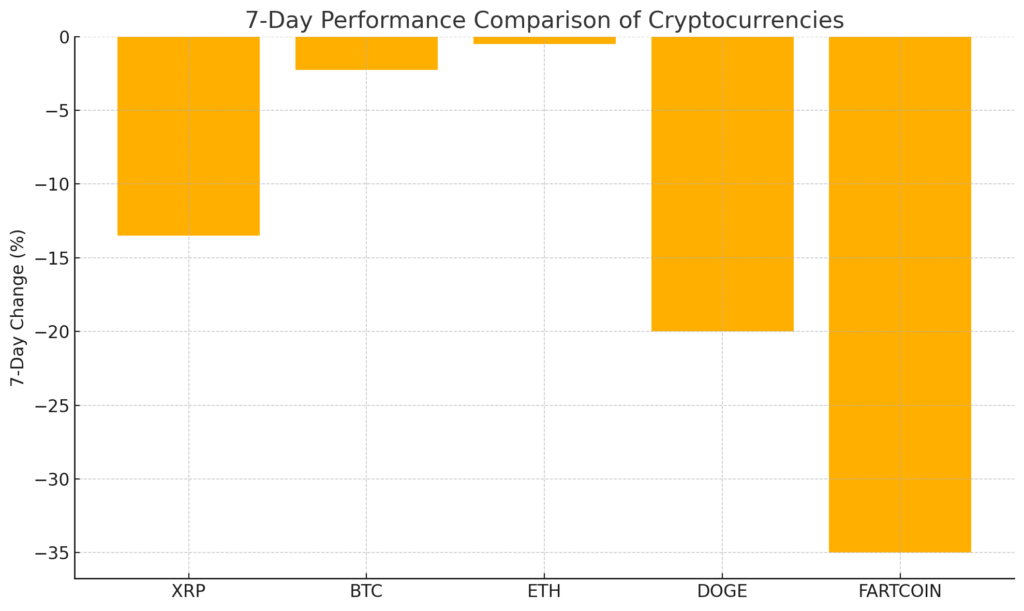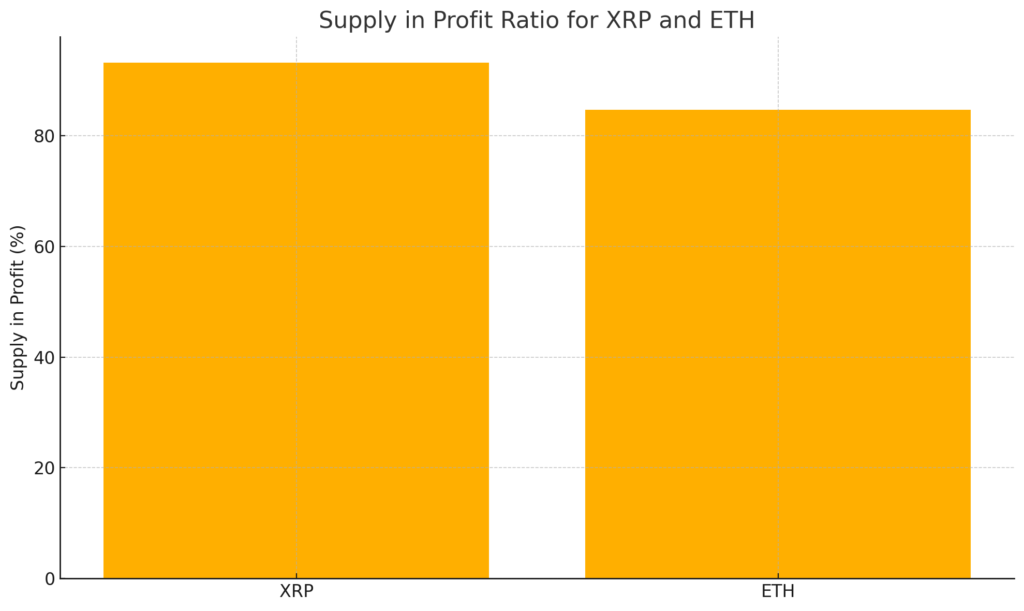
Main Points:
- Significant 7-day price underperformance: XRP down 13.5%, compared with Bitcoin (–2.25%) and Ethereum (–0.5%)
- Founder Chris Larsen moved $175 million in XRP, sending $140 million to exchanges, signaling high-price sell pressure
- 93.24 % of XRP supply in profit vs. 84.70 % for Ethereum, amplifying risk of cascading sell-offs
- Price likely retraced toward short-term holders’ cost basis of $2.30–$2.80
- Institutional landscape evolving: SEC’s new in-kind ETP approvals may redirect flows to Bitcoin/Ethereum products
1. Performance Under Pressure
Over the past week, XRP has been one of the weakest performers among major cryptocurrencies, plunging 13.50 %. By contrast, Bitcoin fell 2.25 %, and Ethereum eased 0.50 % over the same period. Even volatile meme-coins such as Dogecoin and FARTCOIN suffered more extreme declines (approximately 20 % and 35 % respectively). XRP’s steeper drop highlights acute selling sentiment relative to broader market resilience.
(Insert Figure 1: 7-Day Performance Comparison)

Institutional and retail investors have grown wary as XRP underperformed amid broader crypto market consolidation. The relative strength of Bitcoin and Ethereum suggests capital is rotating toward proven assets with deeper liquidity and institutional structures.
2. Founder Transfers Trigger Sell Signal
A pivotal catalyst for XRP’s downturn was large on-chain movements by Ripple co-founder Chris Larsen. Between July 17 and July 29, 2025, Larsen transferred $175 million worth of XRP across four addresses, of which $140 million was deposited into cryptocurrency exchanges. These transfers coincided with XRP trading above $3.60, after which the token slid 10–14 %.
Market participants interpret such founder-driven inflows to exchanges as a signal of impending sell orders. Whales have historically triggered market reversals when moving large balances at or near local highs. Larsen’s actions likely prompted other holders to liquidate positions, further pressuring price.
3. Profit-Taking Risk: Supply in Profit Exceeds 90 %
On-chain analytics from Glassnode show that at XRP’s recent peak of $3.60, 93.24 % of its circulating supply was in profit, compared to 84.70 % for Ethereum. Historically, when profit-supply exceeds 90 %, markets often top out as investors rush to lock in gains, triggering chains of selling.
(Insert Figure 2: Supply in Profit Ratio)

The elevated profit ratio implies that most investors hold XRP above their break-even points. A modest pullback can cascade, as stop-loss orders and margin calls amplify selling pressure, diverting capital to assets with stronger fundamentals or lower risk.
4. Retracing to Short-Term Holders’ Cost Basis
Another typical pattern in crypto corrections is a reversion to the cost basis of recent buyers. Glassnode data indicates that holders who acquired XRP in the last 1–3 months have an average realized price between $2.30 and $2.80. As XRP traded near $3.66, these short-term holders enjoyed 20–30 % unrealized gains.
During the downturn, many of these participants likely rushed to exit positions, driving price back toward their entry points. At the time of writing, XRP trades around $3.13, reflecting this convergence toward the short-term cost zone.
5. Institutional Shifts: In-Kind ETP Approvals
On July 29, 2025, the U.S. Securities and Exchange Commission approved in-kind creation and redemption for Bitcoin and Ethereum exchange-traded products (ETPs), aligning crypto ETPs with traditional commodity ETF mechanics. This change is expected to lower operational costs, tighten bid-ask spreads, and deepen liquidity.
While currently limited to BTC and ETH, this regulatory evolution strengthens the infrastructure for institutional flows. Investors may prioritize these newly efficient vehicles over altcoins like XRP, potentially siphoning capital away from smaller tokens.
Recent Trends and Outlook
Beyond the immediate triggers, broader market dynamics are at play:
- Regulatory clarity around crypto ETPs bolsters institutional confidence. Fundamental improvements in trading efficiency favor leading assets.
- On-chain analytics tools are increasingly guiding traders toward exit points, accelerating corrections when profit-supply is elevated.
- Emerging use cases in decentralized finance (DeFi) and tokenization may redirect developer attention from XRP toward platforms with robust smart-contract capabilities.
For investors seeking new opportunities, monitoring on-chain metrics alongside regulatory developments is crucial. XRP’s current weakness may present a tactical buying zone near the $2.30–$2.80 band, but one must weigh this against macro trends favoring Bitcoin and Ethereum.
Conclusion
XRP’s recent performance slump stems from a confluence of founder-driven exchange inflows, high profit-supply, and profit-taking by short-term holders. While this correction aligns with historical patterns, new institutional frameworks—such as in-kind ETP mechanisms—are reshaping capital flows toward Bitcoin and Ethereum. For investors scouting altcoins, XRP’s pullback offers both caution and potential: understanding on-chain signals and broader market shifts will be key to identifying the next actionable opportunity.

